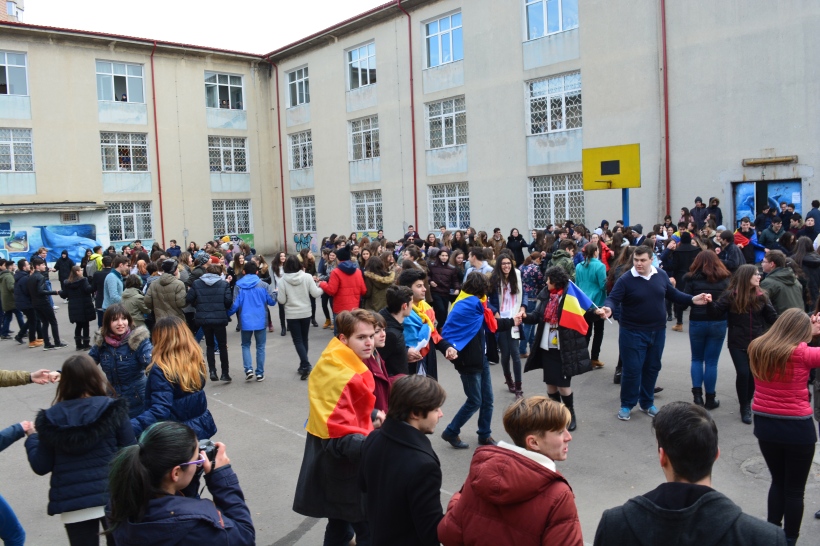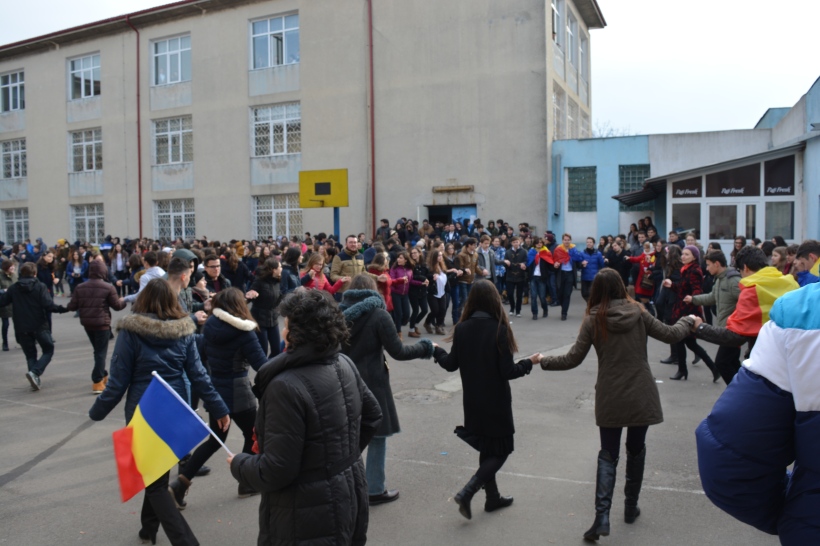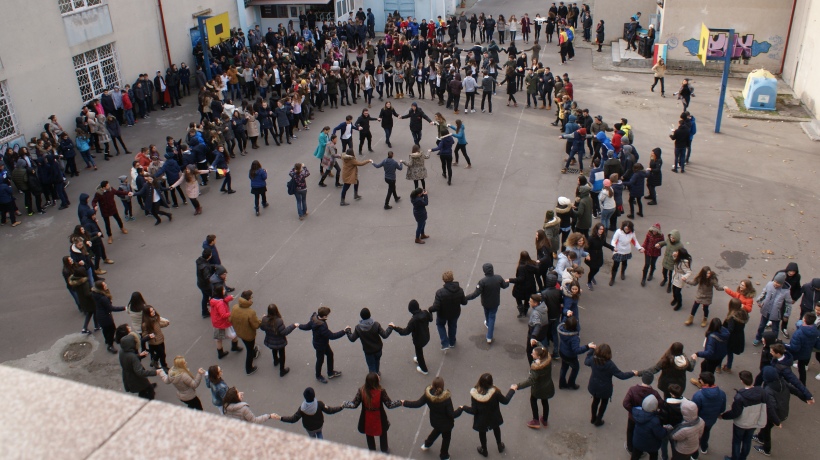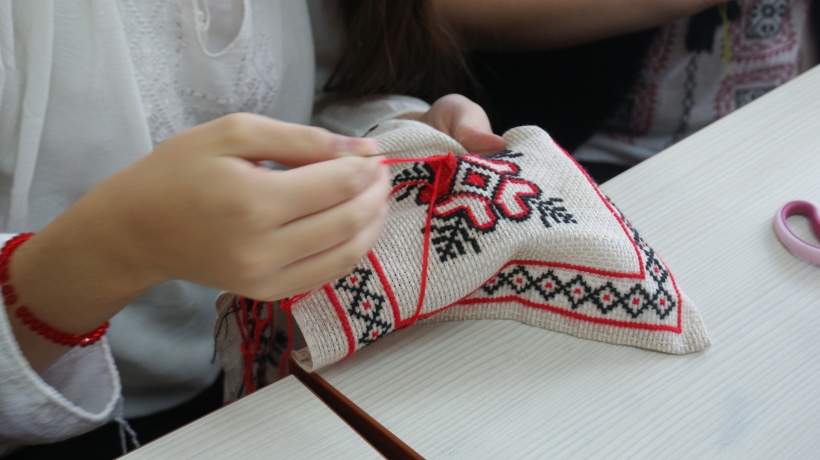
Author: Liceul Teoretic "Ovidius"
Hore (Traditional Dances)
Hora (pl. hore) is a traditional Romanian folk dance where the dancers hold each other’s hands and the circle spins, usually counterclockwise, as each participant follows a sequence of three steps forward and one step backward. The dance is usually accompanied by musical instruments such as the cimbalom, accordion, violin, viola, double bass, saxophone, trumpet or the pan pipes.

The Hora is popular during wedding celebrations and festivals and is an essential part of the social entertainment in rural areas, becoming a dance usually danced in urban areas just at some traditional occasions. One of the most famous hore is Hora Unirii (Hora of the Union), which became a Romanian patriotic song as a result of being the hymn when Wallachia and Moldavia united to form the Principality of Romania in 1859.

1st December represents for the Romanians the day when all three Principalities of Romania got united, therefore it became our National Day. Every 1st of December our school organizes a retrospective day in which we celebrate as our ancestors used to. Hora is the dance that represents us, that’s why all 1200 students get together in this rounded dance and remember that they are proud to be Romanians. Although we do not have live music to accompany us with all instruments, due to technology we could dance happily because our audio system has been able to cover the whole courtyard. And this dance is just a part of our traditions usually developed on 1st of December each year.

Traditional Clothing
Celebrating the 1st of December we could not miss wearing our most precious pieces of clothing, the traditional shirts called “ie”. In the present days we use these shirts just in special cases, such as the National Day, but even if we do not wear them regularly, every girl has at least one in her wardrobe.
The original shirts are truly pieces of art! They are hand-made, with different materials and decorations. They can be made of silk, embroidered with gold thread or colored silk stitches and decorated with pearls. Others are wool based sewn with traditional motifs, by feel they are very soft and thin.
In the medieval period was shaped the aesthetic vision of clothing assemblies worn by Romanians. Socio-economic conditions of the feudal period and administrative-territorial units, that made up the so-called “countries”, gave rise to specific types of costumes with local specificity for the Romanian lands. But regional variations were reported as prototypes and formed the basis, which proved the unity and diversity of Romanian popular costumes.
The climax of the artistic value of traditional costumes was reached in the mid-nineteenth century, when the Romanians spread out the designs throughout all the principalities. In the context of building the national conscience it was settled out the key-insignia of Romanian traditional costumes that distinguish themselves from surrounding ethnic groups.
After World War I, the popular clothing generalized across traditional communities. It remained in the everyday life of the older generation, becoming a ceremonial vestment for the young ones. During the communist period, the creation of new pieces of traditional clothing decreased severely, therefore the original pieces created in the present days or preserved from older times are true values for us.
Wearing these kind of costumes during celebrations helps us illustrate the beautiful Romanian motifs we have, each shirt having original elements, being unique somehow. The colors and materials used and the way it is sewn evaluates the price of these pieces of art, an original shirt made very carefully reaching really high prices.
Popular clothing is now part of our musical traditions as well, every folk soloists or folk dance ensembles having a wide range of costumes.
Click on the photos.
Wearing our tricolor
It is an honor for us during our National Day to display our flag in every possible way. We even wear it attached to our clothing in a smaller version, put near to our heart. This folk custom symbolizes the love for our country, the patriotism, the Romanian blood running through our veins.
The big flags are also part of the tradition, the display of big tricolor canvases being a “must” during the National Day celebrations. Our National Flag is a tricolor with vertical stripes, beginning from the flagpole: blue, yellow and red, “Liberty (sky-blue), Justice (field yellow), Fraternity (blood red)” as established during the revolution in 1848. This combination of colors remained the symbol of our united Principalities, even before they were truly united, representing the Romanians everywhere
Click on the photos.
The play
As our National Day has a very important significance from a historical point of view, some colleagues very keen on history and theater, have decided to put into a play the whole historical event that took place on the 1st December 1918. This National Day was set after the Romanian Revolution and it marks the unification of Transylvania, but also of the provinces of Bessarabia and Bukovina with the Romanian Kingdom, in 1918.
Before all the celebration started, which involved all dances and the traditional music, those 3 talented boys grouped along with other students to form the representatives of each of the 3 Romanian Principalities. Ahead with the National Flag and the blazon of each Principality, they recited the Declarations of Independence made by every representative, literally as they are written in the old history books that mention these documents.
After some solemn moments, all those separated Principalities got together in a dance, the traditional “Hora”, symbol of the union between all the Romanians who lived near one each other, yet so far away.
Besides all the historical significance this holiday has, our community managed to transform a National Event into an artistic moment, which taught us an important lesson about our ancestors and how hard they tried to make our country great and to make us understand that wherever we lived, we were all the same, no matter under what laws were the Principalities ruled.
Click on the photos.
Social Soire
During the 1st of December celebrations, our community develops all the artistic skills we, Romanians, have. Along with dancing, singing and wearing the traditional clothing called “ie”, we also learn how to sew our traditional motifs on pieces of cloth. All children gathered together learn how to sew from our teachers, who already know all the tricks, because we have to preserve our traditions in order not to waste them.
Click on the photos.

While sitting together and sewing, children also remember to socialize with each other, because this was the true meaning of a social soire back then, in the times of our grand-grandparents. They gathered every Sunday to dance and to sew, to exchange experiences and opinions together, meeting every time new people and learning from them the most interesting things.
We tried to reproduce a day as it was in the past, therefore we could not miss the beautiful gatherings into a social soire, developed not in an old rural house’s garden, but in our classrooms, in the middle of the city of Constanta.
Galita
Due to the fact that our National Day opens the winter season in which Christmas is a very significant holiday for Romanians and many other nations, our scholar community also makes charitable acts, as it is a tradition to make gifts especially to people that are not so lucky as we are.
Before Christmas, we raised funds and bought food and toys for the children and families who live in a very poor city in the South-East of Romania called Galița, nearby the county of Constanta. We were happy to go there and give them all our gifts and we received exactly what we wished for: tons of smiles and lots of happiness. They even welcomed us with Christmas carols that moved us sincerely, as they sang so purely as if they were some small angels. Their happiness was immortalized within our photos, that will surely remain a great memory from the last Christmas.
Click on the photos.


















































